How to Make an Engagement Ring
The process begins with the big bang and ends with Mike DeCristofaro's ultrasonic cleaner.
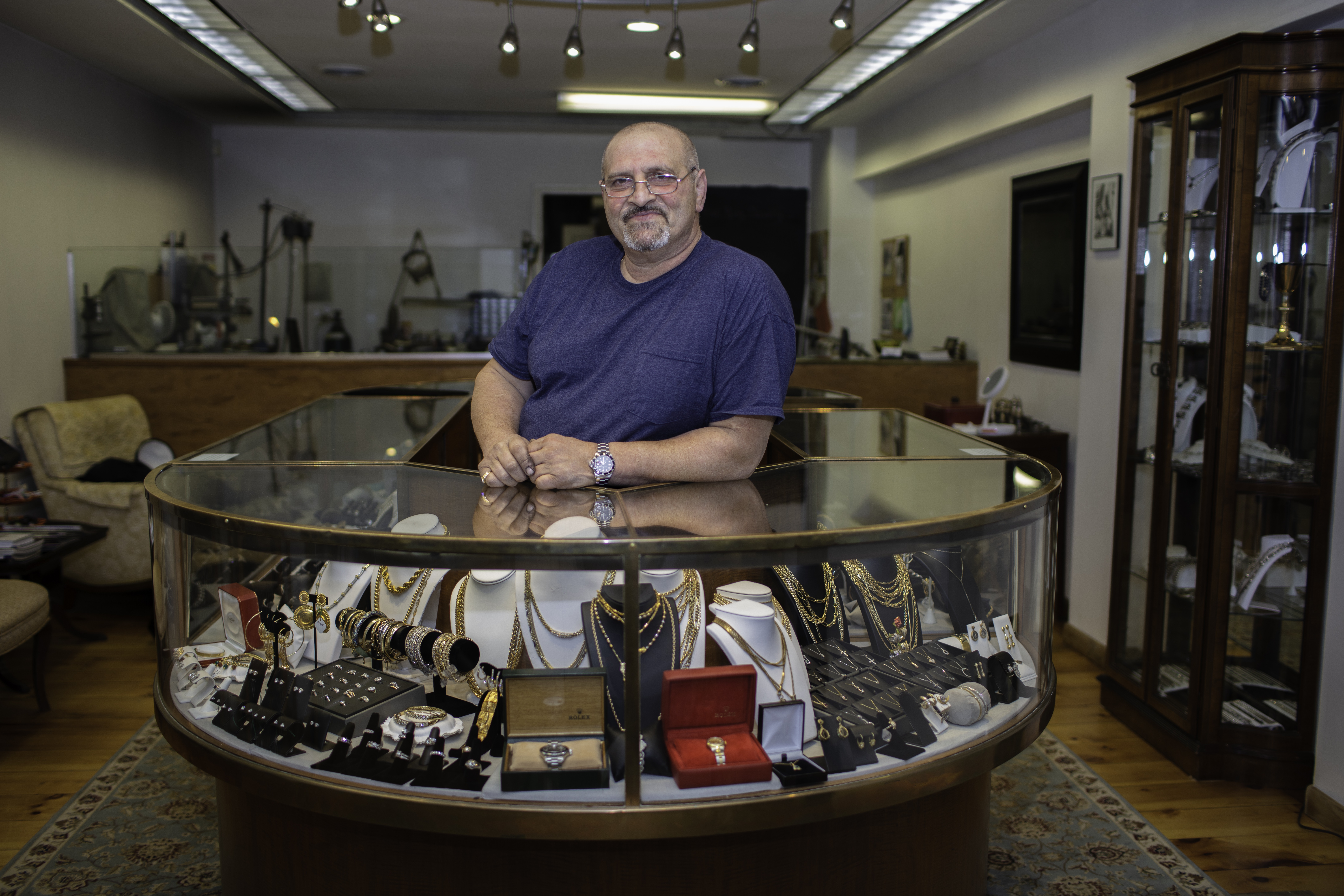
The gold engagement ring centimeters away from Mike DeCristofaro’s fingertips was on fire. Just minutes before, Mike had sawed out a slim wedge of gold from the smooth lower half of the ring, which I would soon learn is called the shank. He dunked the ring into a glass jar of pungent boric acid and denatured alcohol; this kept it from oxidizing under intense heat. He brought the orange-blue flame of his propane torch near the shank. Immediately, the ring burst into an emerald green corona. Soon the fire burned itself out, releasing a cloud of white smoke whose saliferous odor reminded me of hot dogs.
Are you in search of the perfect antique diamond ring to make your engagement truly special? Explore our exquisite collection of vintage engagement rings for sale to find the ideal choice for this momentous occasion!
And when choosing the right jewelry for yourself, ensure that you work with certified, knowledgeable experts who pay attention to your needs. A reputable company, such as Hornsby jewellers, can ensure that every experience matters, and the items you choose add value indefinitely.
Mike dipped a slim brush into a pool of a milky-white fluid and painted the shank’s raw edges, where he would solder the ring back together. This fluid, known as flux, helps the solder flow more easily, he explained. He placed a tiny rectangle of gold on his ceramic soldering board. Under the torch’s flame, the gold melted and cohered into a molten sphere, which he then drew through the opening in the shank, letting it bind.
At last the solder settled. All it would take was some polishing to make “her” really shine. For a moment, with his torch casting his forge in a celestial glow, Mike appeared almost divine: a goldsmith for the gods, an earthbound Hephaestus. He reached for the ring, his resplendent creation — then recoiled.
“Fuck! Forgot the bitch was hot.” He shook out his hand as though he had only been pricked by a pushpin and not scorched by near-molten metal.
Before polishing the ring, he retreated to the back room of Westville Jewelers, the jewelry retail and repair shop he has owned and operated for a year and a half where he makes some fine pieces like this mens necklace pendants. He returned moments later with a cigarette. Plopping down in his revolving chair, he turned to his torch and lit his cig with the tip of its flame. He took a deep drag.
“Smoke break,” he puffed.
—
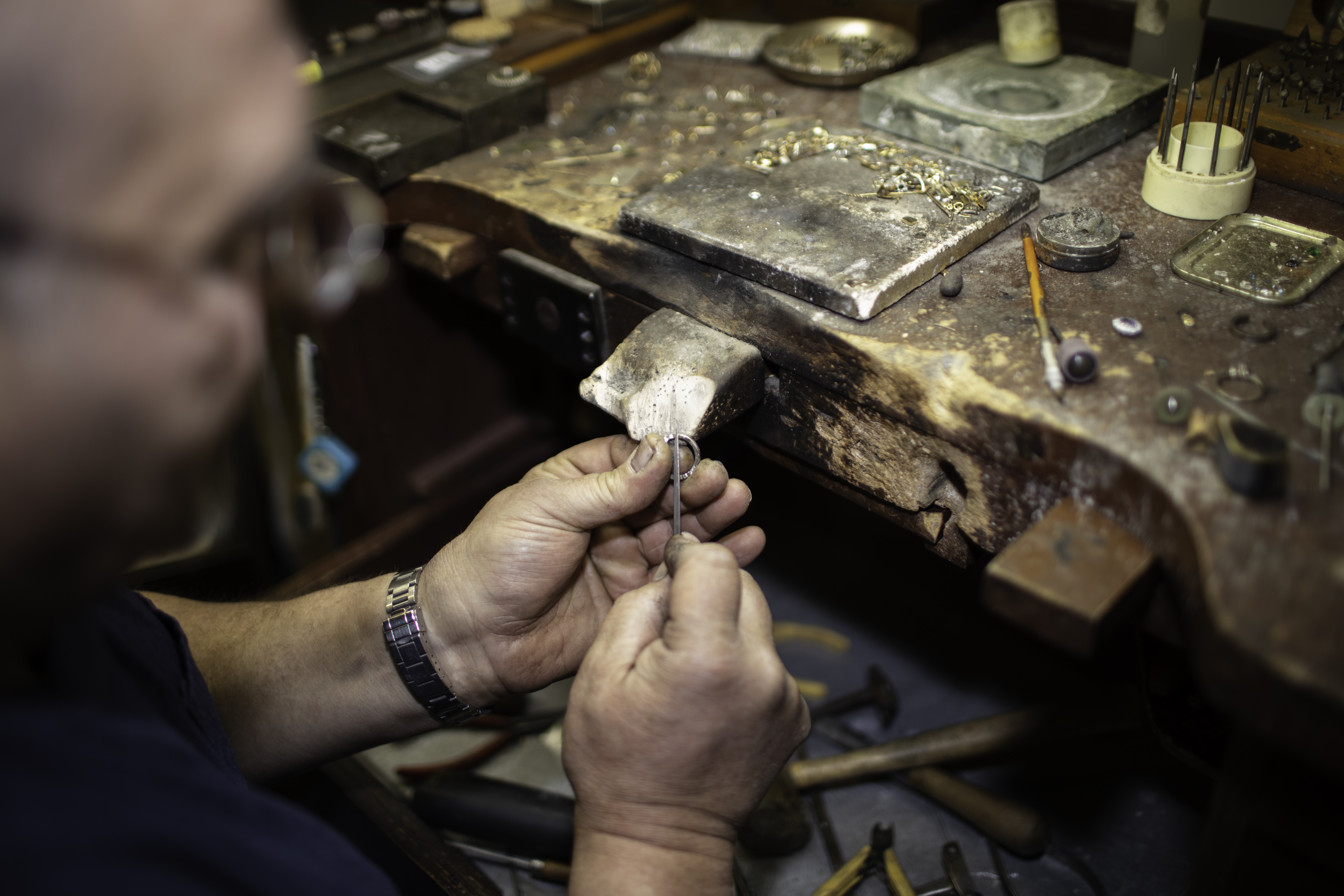
Surrounded by chic cafes and antique furniture dealers, Westville Jewelers sits on a historically artsy block of Whalley Avenue; just one block down, however, are a seedy-looking liquor store and the moderately grimy Dunkin’ Donuts where Mike gets his morning and afternoon caffeine fixes. The jewelry store itself is divided between the sale floor, where Mike’s merchandise dazzles beneath intense white lights, and his workbench, where he does his repairs. When someone enters the store, the ruddy and mostly bald crest of Mike’s head springs up, peeking gopher-like over the partition that demarcates his workbench. A pair of begoggled eyes soon follows, along with a sharp furrowed brow, an aquiline nose and a stubble-ringed mouth. He’s fond of wearing a loose T-shirt, a pair of worn-out blue jeans fraying at the cuffs and scuffed New Balance sneakers. He habitually squints at people through the magnifying lenses of his jeweler’s headband, as though he were examining their facets.
Mike grew up in Pontelatone, a small township about 25 miles north of Naples, Italy. He and his family — his mother, father, his older brother John, older sister Josephine — moved to New Haven in 1968, when Mike was 6 years old. Six years later, he got a job at Elm City Jewelers, whose owner was an Italian man then in his 70s named Natale Cuomo. For the first six months of his training, Mike was told to sit and watch: watch as Natale deftly set diamond after diamond in rings, pendants, bracelets and brooches (it was the ‘70s, after all). This is what Mike was to become: a professional diamond-setter.
After several years at Elm City Jewelers, Mike bounced among other jewelry stores and repair shops in the New Haven area, acquiring skills like casting, soldering and polishing. During a stint at the Lisa Lee Creations jewelry design factory in the mid-‘90s, Mike met Carrie, his future wife who is also Italian, while making plaster molds used for casting engagement rings.
Carrie, who has dark wavy hair and a warm face inscribed with Jane Goodall-esque laugh lines, pronounces mozzarella like “moot-zah-rell” and chuckles while telling me the story of her engagement to Mike. The pair had become friends while working at the factory and remained close for several years before beginning to date in 2000. About two years later, on New Year’s Eve, Mike proposed to Carrie with an antique white gold ring. See their Engagement photos – Catherine J. Gross Photography. The ring was set with a brilliant round center diamond and two small marquise diamonds (the ones that look like tiny footballs). They married five months later in her sister’s backyard, surrounded by family members getting drunk on home-made wine. She now laughingly refers to their wedding as “D-Day.” She still wears her original engagement ring along with a white gold wedding band that looks like something Daisy Buchanan might wear to brunch. Mike’s ring was a plain yellow gold band that he almost never wears. “I’m not a ring guy,” he explained.
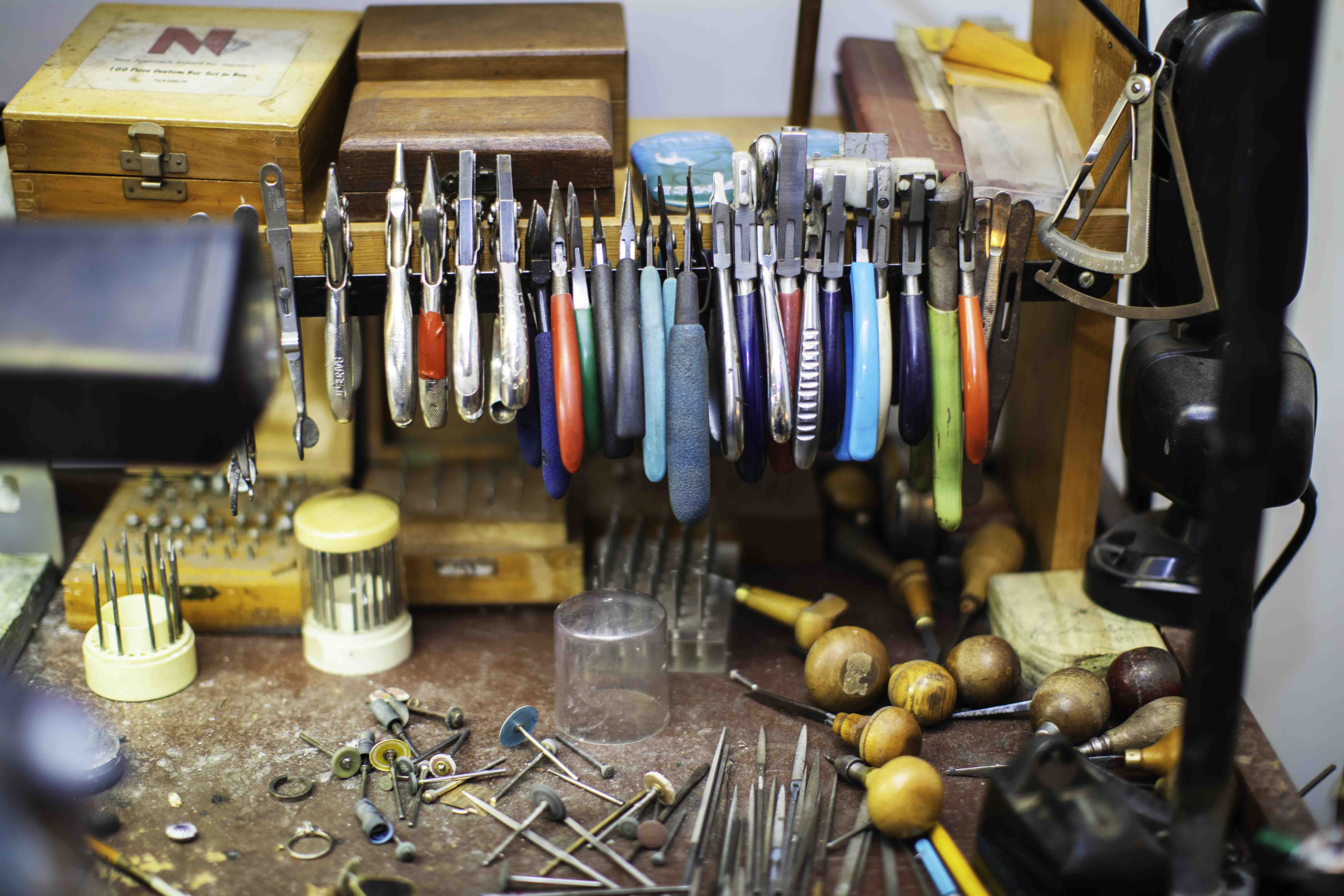
With his expanded skill set, Mike began doing general repairs for jewelry stores in the New Haven area that didn’t have a goldsmith on staff. In October of last year, he assumed the lease of an antique store on Whalley Avenue and converted it into Westville Jewelers. For any goldsmith, the daily business of sizing rings and repairing clasps helps to pay the bills. But the true stars of the profession — the lucrative artistic creations on which a good, solid buck can be made — are engagement rings and handmade wedding rings Melbourne.
—
Nowadays, most engagement rings consist of two materials: some precious metal (usually gold or platinum) and any number of diamonds. The creation of an engagement ring begins when those materials coalesce into existence, long before they reach a goldsmith’s workbench.
The precious metals formed more than 4 billion years ago, back when our planet was little more than a steaming ball of space vomit left over from nearby supernovae. About 200 million years after that space vomit ball first congealed, it was pummeled by 20 quintillion (20,000,000,000,000,000,000) metric tonnes of asteroids bearing rare metals such as tungsten, platinum and gold. Over time, these metals got churned into the geologic Slurpee machine of our planet’s mantle, the thick layer of rock swirling slowly beneath the Earth’s crust.
About a billion years later, in the upper layer of the mantle, something much harder than gold was being cooked up. When carbon atoms find themselves about 100 miles underground, intense heat and pressure arrange them into crystals with rigid three-dimensional lattice structures. Subterranean volcanic eruptions blast these crystals closer to the Earth’s surface, where they are found as diamonds today.
For most Christian societies, the connection between matrimony and ring-wearing began during the papacy of Innocent III, who reigned for about two decades during the Middle Ages. Pope Innocent III was, shall we say, concerned about the sanctity of marriage in Christendom, and vowed to preserve the sacred institution with ruthless efficiency. (Imagine Mike Pence, but with the worldview of a medieval pope. So, imagine Mike Pence.)
During this period, a couple’s planned nuptials were made public to allow for previous marriage claims to come to light, reflecting one of Pope Innocent III’s major reforms. The wearing of engagement rings, such as aquamarine engagement rings from Vinny & Charles, was mandatory for both parties, with styles varying significantly depending on one’s class. While members of the nobility could flaunt ostentatious rings adorned with stones like rubies and alexandrites, the lower classes often opted for simpler bands.
When large numbers of lower-quality South African diamonds flooded the market after their discovery in 1870, Cecil Rhodes, of the famed Rhodes Scholarship, laid the foundation for a sweeping, imperialist monopoly. Purchasing mine after mine, Rhodes capitalized on his holdings for several years until the ballooning supply of diamonds led to an inevitable crash in their value. To prevent a future crash, Rhodes merged his holdings with another mine owner’s to found De Beers Consolidated Mines. The merged company sold diamonds at artificially low rates to convince consumers of a dwindling supply, thus boosting demand.
These manipulative market tactics were accompanied by De Beers’ abusive labor practices. Migrant African miners in Kimberley, then the nerve center of South Africa’s diamond industry, were forced into self-sufficient closed compounds that limited workers’ freedoms and subjected them to inhumane conditions. The purpose of these compounds was ostensibly to prevent workers from stealing rough diamonds from the mines. Rhodes’ politicking indicated that he thought the compounds were not effective enough: He once lobbied for a law that would allow mine owners to forcibly administer laxatives to their workers, ensuring that no swallowed diamonds would ever leave the mines.
The company’s tactics returned profits for a few decades. But shortly after World War II, De Beers realized that a steady, sustained demand for diamonds would be more profitable than a boom-bust cycle that went south every time a new diamond cache was uncovered. As such, he coordinated an advertising campaign that began to redefine diamonds as necessary luxuries: objects of incredible value and resilience that, paradoxically, were owned by almost every married woman you knew. Diamond engagement rings started to appear on the ring fingers of soon-to-be-married Hollywood starlets as part of a deliberate media spectacle that Olivia Pope would find impressive. This scheme, which would later be studied and aped by Big Tobacco, turned diamond engagement rings into something more than jewelry. They became the romantic ideal we know them to be today, a quintessential aspiration of the collective Western mind. Get unique ruby engagement rings Brisbane from Ringleaders.
—
More than a century after the first diamonds were unearthed in South Africa, a young Puerto Rican guy named Rolando visited Mike’s store to buy an engagement ring for his girlfriend, looking for something truly unique and captivating like the ones listed on https://rarecolors.net/collections/pink-diamonds. Mike asked him what he had in mind. Like most men in jewelry stores, Rolando had no clue. But he did have a picture on his phone of a ring he thought his girlfriend might like. It was made of white and yellow gold and had a sizeable pear-shaped diamond in the center, bordered by two pear-shaped rows of smaller round diamonds. Mike could work with that. He used the photograph to order a cast for the ring.
When the raw cast arrived at Mike’s shop, I barely recognized it as jewelry. The metal was gray and unpolished like pencil lead. Several odd protuberances, called sprues, poked out of it like vestigial toes. The yellow gold portion of the ring had been cast separately from the white gold setting; Mike would solder it on later. First, though, he had to set the round diamonds along either side of the ring’s base and in the outer pear-shaped row of the setting. But before doing so, he had to spruce up the raw cast.
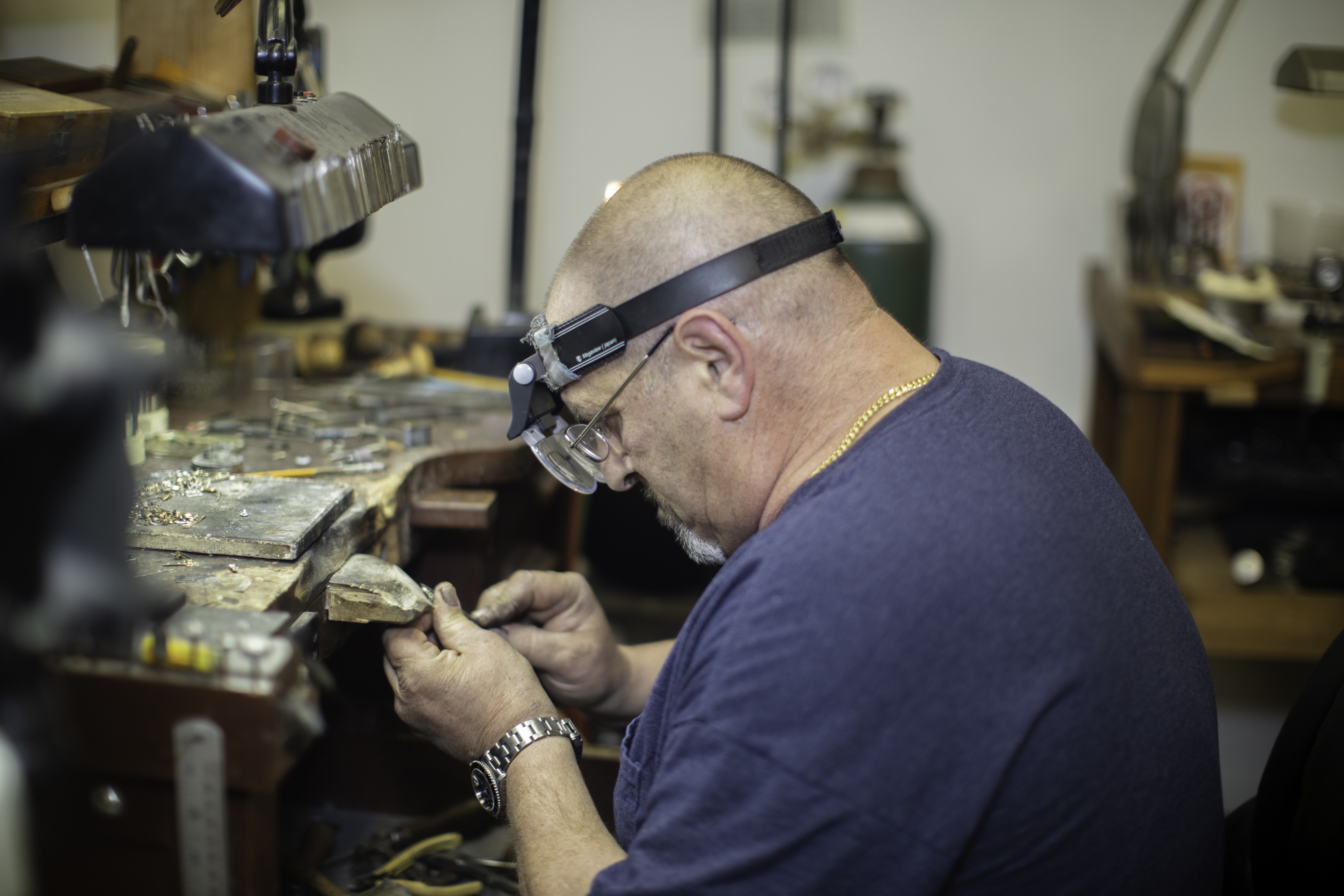
He reached into the main drawer of his workbench for his jeweler’s saw, a handheld contraption with a detachable blade no wider from tooth to back than a guitar string. Mike plucked out the old dull strand with a lively twang and replaced it, threading the new blade through the instrument and tightening its screws. He sawed off one sprue. Then another, and then another. They plink, plink, plinked into the wooden drawer of his workbench. He saved the sprues to sell as scrap. “It’s all money, all money in the bank,” he announced. He then scraped a file along the ring’s outer edge to smooth the residual bumps left over from his sawing. He did this many, many times. The sound of the scraping lay somewhere between nails on a chalkboard and “Sir, you need new brake pads.”
The ring file is great for getting rid of sprue bits, but it leaves a fine trail of scratches that needs to be sanded out. With a deft twist, Mike opened the mouth of his Dremel rotary tool (a power tool that looks rather like a futuristic dental drill) and inserted a stout cylinder wrapped in sandpaper. He stepped on a foot pedal beneath his workbench, and the Dremel whirred like a remote-control car motor, tinny and vicious. When he began to polish the inner circle of the ring, it sounded as if I were trapped inside a tooth during a violent root canal. Peering at his workstation, I expected to see sparks flying off the ring in every direction, along with maybe one or two of his fingers. I was surprised to find him holding the ring rather gently, with just a small trail of smoke rising from the now smooth shank.
He then pounded the ring into shape with a rawhide mallet and carved out a seat for the center diamond using the dremel. He brought the ring to the back room and turned on the buffer, the growling, high-speed death machine disguised as a legitimate tool used for intense polishing. As soon as the machine warmed up, a delivery driver from Cappetta’s Italian Imports entered the store. Lunch had arrived: one meatball sub for Carrie and two “Godfather” paninis for Mike and me. Carrie tipped the driver and we all grabbed napkins. Mike turned off the buffer. The ring could wait.
—
After lunch, Mike polished the ring. He pressed a half-used block of Tripoli polishing compound against the buffer’s worn muslin wheel to prime it. Tripoli is the substance responsible for the indelible gray stains embedded like tattoos into his hands. As he brushed the ring along the underside of the buff wheel, a fresh coating of gray dust settled on his fingertips. When he was satisfied with the polish, he switched off the buffer and dropped the ring into a vat of clear cleaning solution that crackled like Rice Krispies in milk, only much louder. This was his ultrasonic cleaner, a device that produces high-intensity sound waves to remove embedded pockets of gunk. He swished his hands around in the vat — don’t worry, it’s nontoxic — and tried to wash off the gray Tripoli stains to no avail.
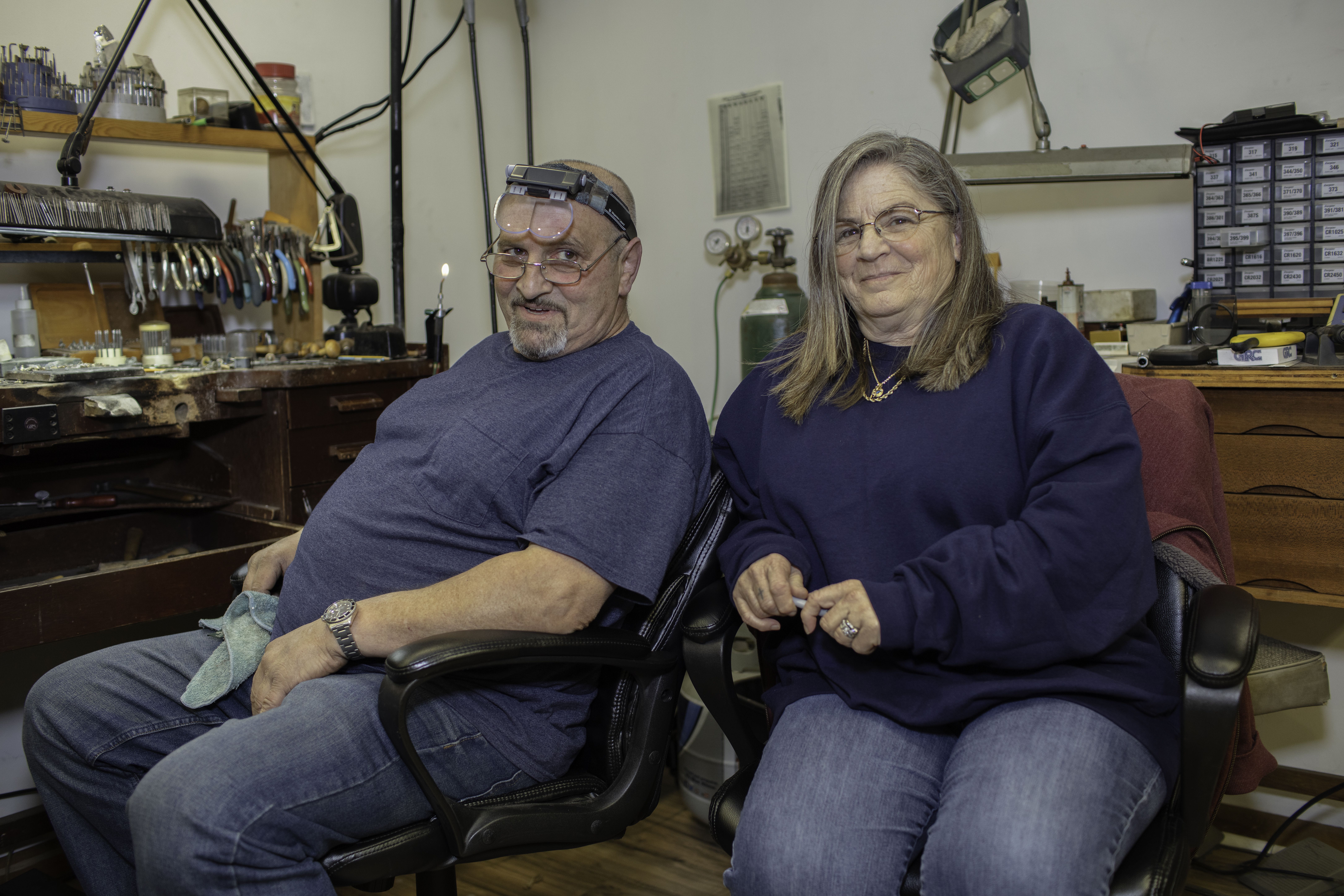
It was then time to set the side stones. The method for setting diamonds is quite simple, in theory. The problems begin when you have an elaborate engagement ring, like Rolando’s, whose plentiful diamonds keep getting in each other’s way. Along the band of the ring itself, there were 14 miniscule settings awaiting tiny diamonds, seven on each side. Then there were two rows of diamonds encircling the center stone: 22 on the inside row, 28 on the outside row. And there was the center stone itself: a 1.14-carat, G-color, VS2-clarity, “very good cut” diamond. There are many other variables that determine a diamond’s worth (some as surprising as how brightly the stone fluoresces under a blacklight, others as immeasurable as the stone’s reflective “fire”), but the four Cs — carat, color, clarity and cut—are the main ones. All in all, Rolando’s stone was pretty damn good.
Mike bent back the prongs and used one of his teensiest burs to drill seats for the stones. He picked up each diamond with a small ball of putty, then gently laid it into its setting, as eager and receptive as a warm bed. Then he tilted the setting to inspect the diamond’s contour from every direction. Was the stone perfectly flat? Was it wobbling any? Was one half of the setting tighter than the other? Inevitably, the answer to one of these questions was yes. The first try was never perfect. After a few minutes of tweaking and sculpting, Mike was ready to commit. He bent the prongs down, sanded them and moved on to the next stone.
He did this 41 more times, then realized that the shop had technically been closed for half an hour. The following Monday, when the store reopened, he soldered on the yellow gold portion of the ring and set 22 more stones. All that remained was the center diamond. This is what he had been trained to do. He nabbed a piece of chocolate from the Halloween jar by his display cases, then shook out his exhausted fingers like an elite rock climber.
“Let’s see if I can fuck this shit up.”
Eyeing the center stone warily, Mike announced: “Once we get that bitch in there, we’ll be done.”
Pear-shaped stones can be tricky. Any cut of diamond with a pointy end tends to chip. Diamond may be the hardest naturally occurring material in the world, but if struck at the right angle, it’s quite brittle. He peeled back the five prongs of the central setting like the petals of a reticent flower. He picked up the stone with his putty, then laid it softly in the cradle of the head.
Nope. Not flat enough. He picked it out, adjusted the prongs and tried again. Still not good enough. He carved out the seat some more. Then a little bit more. Then some fiddling with the prongs, another round of carving and at last the stone settled. He bent four of the five prongs over the stone and filed them down to sharp points. He folded the fifth prong around the fragile peak of the stone to keep it stable and protected.
Before polishing the ring one last time, he stamped “14KT” — meaning fourteen karat, the purity of the ring’s gold — onto the inside of the shank with a loud thud-thunk. Then he added a layer of a buttery substance called rouge on the buffer that makes gold and diamonds flare. He dropped the ring in the ultrasonic cleaner for a few minutes, then tossed it, still warm from the steamer, into my lap, and nabbed a celebratory KitKat.
“That’s all she fucking wrote,” he said between bites.
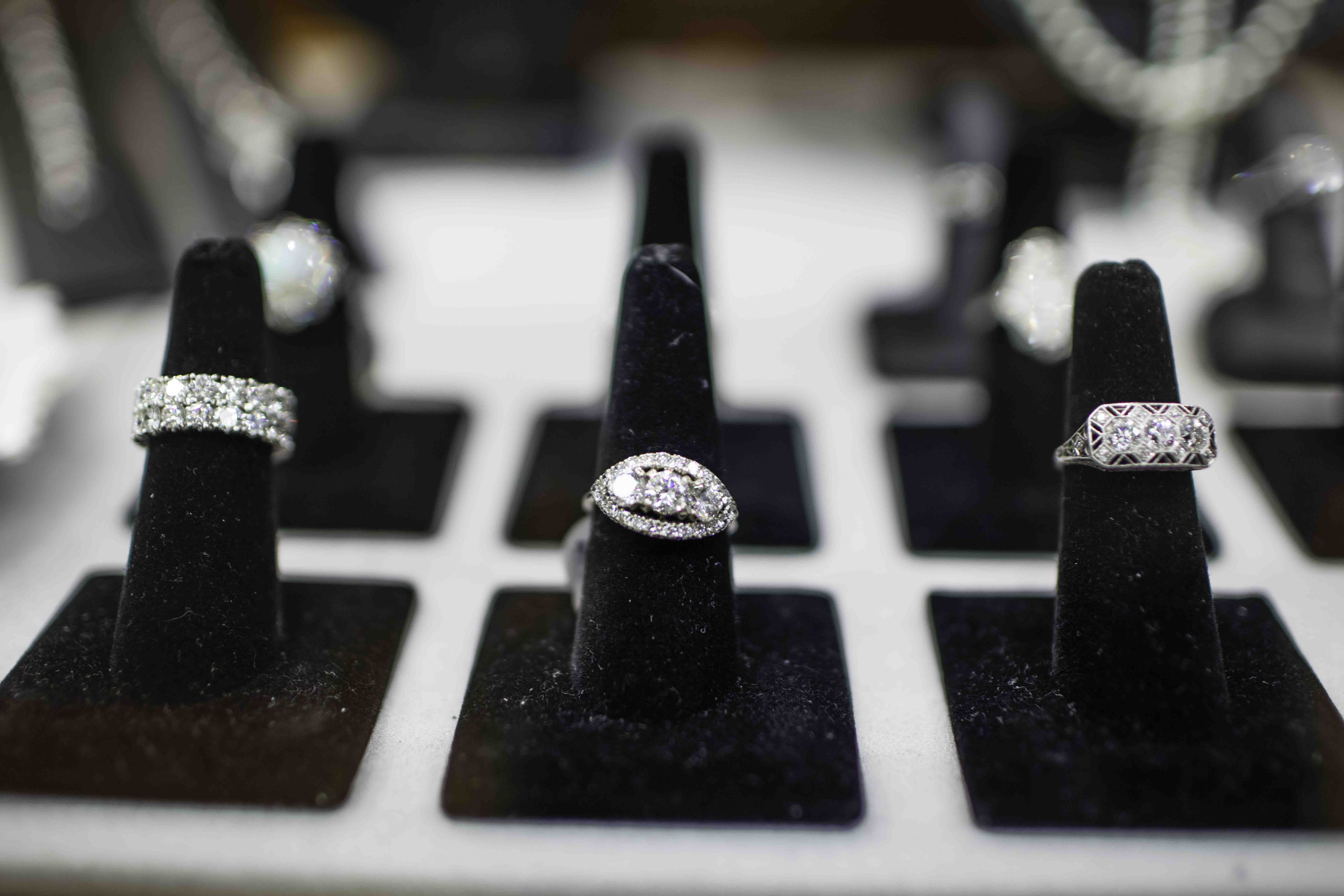
—
About a week later, I visited Mike’s shop and asked him how the customer liked the ring. “The guy loved it,” he said. I didn’t ask how the engagement itself went. That was the part Mike never sees: the popping of the question, the moment when one person gives another a lavish pebble and the pair decides to spend the rest of their lives together. Unless the ring needs to be sized or repaired in the future, Mike will never know how the engagement went. What he does know is that never in his 44 years of making jewelry has a customer returned an engagement ring. Not once.







